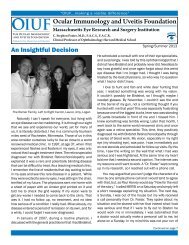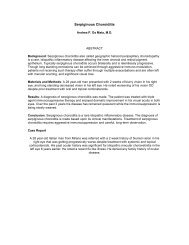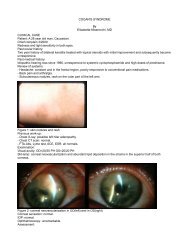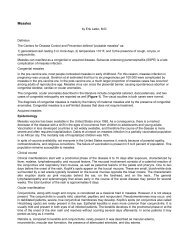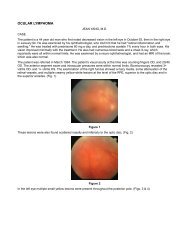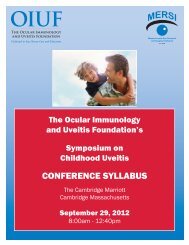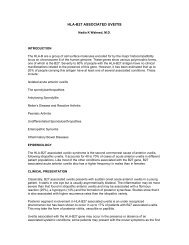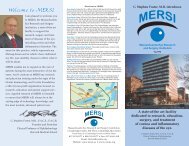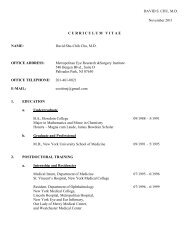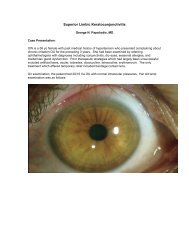Case Presentation
Case Presentation
Case Presentation
Create successful ePaper yourself
Turn your PDF publications into a flip-book with our unique Google optimized e-Paper software.
<strong>Case</strong> <strong>Presentation</strong><br />
Peter Chang, M.D.<br />
Research Fellow<br />
Massachusetts Eye Research<br />
and Surgery Institution<br />
9/5/2008
Patient <strong>Presentation</strong><br />
CC: Fixed, dilated pupil after penetrating<br />
keratoplasty for scarred cornea, OS<br />
HPI: 45yo female presents with a fixed, dilated<br />
left pupil, associated with significant<br />
photosensitivity OS, 5 days after PK for her<br />
extensively scarred left cornea. The patient had<br />
a history of herpectic keratitis in the left eye<br />
which caused severe scarring, rendering poor<br />
VA at 20/300. Therefore, PK was done.
Patient <strong>Presentation</strong> (cont)<br />
The transplant was successful without<br />
complications. Topical steroids and<br />
antibiotics were used both pre-op and<br />
post-op. op. No mydriatic was used. Both<br />
continuous and interrupted sutures were<br />
employed to center the graft.
Patient <strong>Presentation</strong> (cont)<br />
On POD1, Pt presented with conjunctival<br />
injection 2+, corneal graft edema 2+, AC<br />
cell 2+, PERRLA; no wound leakage. VA<br />
20/150, IOP 19. She was maintained on<br />
Pred Forte q2h and Zymar QID.
Patient <strong>Presentation</strong> (cont)<br />
On POD7, Pt returned with a complaint of<br />
increasing light sensitivity and 8/10 pain, OS.<br />
She also noticed in the mirror that her left pupil<br />
had been dilated over the past 2 days.<br />
Exam findings:<br />
– VA 20/125 (20/100ph)<br />
– IOP 46 mmHg: drops were inititated<br />
– Conj injection 1+, graft edema 1+, AC cell 1+<br />
– OS pupil diameter was fixed at 8mm, while OD pupil<br />
was PERRLA<br />
– Wound intact, all sutures buried
Patient <strong>Presentation</strong> (cont)<br />
On POD8, Pt returned with persistent light<br />
sensitivity, though the pain was<br />
considerably better. Her vision remained<br />
blurry, and her pupil was still fixed and<br />
dilated.<br />
Exam findings:<br />
– Same as POD7, except OS IOP is down to 30<br />
mmHg: antihypertensive regimen was<br />
continued.
Patient <strong>Presentation</strong> (cont)<br />
POD14: Pt returned with slightly better<br />
light sensitivity and mild pain. All the post-<br />
operative parameters were improving. The<br />
only exception was the fixed, dilated pupil<br />
in the left eye, unresponsive to pilocarpine.<br />
Steroid taper began.<br />
Exam findings:<br />
– VA 20/100 (20/80ph)<br />
– IOP 17mmHg
Dilatation<br />
What is with that Pupil?<br />
(Differentials)<br />
– Sympathetic (excitement, fear)<br />
– Anti-parasympathetic (ex. drugs)<br />
– Midbrain damage (ex. grand mal)<br />
– Increased IOP (iris ischemia)
What is with that Pupil? (cont)<br />
Constriction<br />
– Automonic nervous sytem (sleep)<br />
– Narcotics<br />
– Pilocarpine/phospholine iodide<br />
– Pontine hemorrhage<br />
– Aging<br />
Irregular shape/size<br />
– Trauma<br />
– Inflammation<br />
– Neovascularization<br />
– Coloboma<br />
− Aniridia<br />
− s/p CE (most common)<br />
− Tadpole pupil (migraine)<br />
− Midbrain damage
Urrets-Zavalia Syndrome (UZS)<br />
An uncommon post-operative operative complication<br />
in which a pupil remains fixed and dilated,<br />
accompanied by iris atrophy and<br />
occasionally secondary glaucoma. . These<br />
pupils are unresponsive to miotic agents.<br />
The exact features are in fact quite<br />
variable among published reports/series.
History<br />
First described by Dr. Urrets-Zavalia in<br />
1963, after PK for keratoconus. He<br />
associated that with the post-op op mydriatic<br />
treatment. He attributed this discovery to<br />
Dr. Castroviejo in the 1940s.<br />
– Dr. U-Z: U<br />
6 patients had the syndrome for up to<br />
6 weeks, but all resolved spontaneously.<br />
– In 1967, Uribe et al described the syndrome in<br />
PK patients without post-op op mydratics.
History<br />
Classically linked to PK for keratoconus<br />
Subsequent reports suggest that UZS can<br />
also be seen after:<br />
– Deep lamellar keratoplasty for keratoconus<br />
– Descemet stripping endothelial keratoplasty for<br />
Fuch’s s endothelial dystrophy<br />
– Argon laser peripheral iridoplasty<br />
– Surgical trabeculectomy<br />
– Phakic ACIOL implantation
Epidemiology<br />
Incidence: 2.2% – 17.7%<br />
This seems to be decreased in the recent<br />
years; some even question its continued<br />
existence.<br />
Likely due to improved surgical techniques<br />
and/or different diagnostic standards.
Variable Degrees of Dilatations<br />
Typically, 3 types of pupil dilatations can<br />
be seen in UZS:<br />
– At least 1.5mm larger than the fellow<br />
unoperated eye, but responds to miotic<br />
agents (90%)<br />
– Unreactive and paretic, but slowly returns to<br />
normal after time (some up to 1 yr)<br />
– Irreversible dilatation with iris atrophy
Possible Mechanisms<br />
Strong intra-op mydriasis brings iris into contact<br />
with peripheral cornea, producing peripheral<br />
anterior synechiae and glaucoma (Dr. U-Z) U<br />
Relative pupillary block<br />
Pre-existing existing pupillary abnormalities<br />
– Hyperreaction to mydriatics, as seen in Keratoconus and<br />
Down’s s Syndrome<br />
– Iris plataeu syndrome<br />
Intraoperative trauma causing strangulation of iris<br />
vessels
Possible Mechanisms (cont)<br />
Intra-op IOP elevation causing occlusion of<br />
scleral vessels which leads to iris ischemia<br />
Damage to ciliary ganglion during sub-tenon<br />
injection of anesthetics<br />
Abnormalities of the sympathetic nervous<br />
system<br />
Overuse of general anethesia<br />
Intra-op exposure to other toxins
Treatment/Prevention<br />
Avoid using mydriatic agents following surgery in<br />
vulnerable eyes (keratoconic).<br />
Laqoutte (1983) proposed a regimen of<br />
sympatholytic drop (guanethidine) q4h for 1 day,<br />
followed by pilocarpine 2% for several days.<br />
Naumann (1997) recommended performing PI in<br />
all phakic patients undergoing PK.<br />
Special surgical techniques of PK have also<br />
been proposed to prevent iris damage (Loden<br />
and Price, 1998).
What Happened to the Patient?<br />
After 6 months, Pt returned with OS VA of<br />
20/40. There was no evidence of<br />
inflammation or graft failure. IOP had<br />
remained in the normal range, so anti-<br />
glaucoma drops were discontinued.<br />
However, the patient had significant glare<br />
(no photophobia or pain), as the OS pupil<br />
was still fixed and dilated, with no<br />
improvement.
What Happened to the Patient?<br />
(cont)<br />
Iris fluorescein angiography disclosed large area<br />
of non-perfusion in the left iris.<br />
OD<br />
OS
End of the <strong>Case</strong><br />
Finally, decision was made to reconstruct<br />
the iris. Afterwards, her left eye had no<br />
more glares.
References<br />
Urrets-Zavalia A. Fixed dilated pupil, iris atrophy and secondary glaucoma: a distinct<br />
clinical entity following penetrating keratoplasty for keratoconus.<br />
Am J Ophthalmol.<br />
1963; 56:257-65.<br />
65.<br />
Gasset AR. Fixed dilated pupil following penetrating keratoplasty y in keratoconus<br />
(Castroviejo syndrome). Ann Ophthalmol. 1977; 9:623-8.<br />
Davies PD, Ruben M. The paretic pupil: its incidence and aetiology after keratoplasty<br />
for keratoconus. Br J Ophthalmol. . 1975; 59:223-8.<br />
Tuft SJ, Buckley RJ. Iris ischemia following penetrating keratoplasty for keratoconus<br />
(Urrets-Zavalia syndrome). Cornea. . 1995; 14:618-622.<br />
622.<br />
Maurino V., Allan BDS, Stevens JD, et al. Fixed dilated pupil (Urrets Zavalia syndrome)<br />
after air/gas injection after deep lamellar keratoplasty for keratoconus. Am J<br />
Ophthalmol. 2002; 133:266-8.<br />
Srinivasan M., Patnaik L. Fixed dilated pupil (Urrets-Zavalia Syndrome) in Corneal<br />
Dystrophies. Cornea. 2004;23:81-83.<br />
83.<br />
Yuzbasioglu E, Helvacioglu F, Sencan S. Fixed, dilated pupil after phakic intraocular<br />
lens implantation. J Cataract Refract Surg. . 2006 Jan;32(1):174-6.<br />
Edgar Espana, Alex Ioannidis, Celso Tello, Jeffrey M Liebmann, Paul P<br />
J Foster, and<br />
Robert Ritch. Urrets-Zavalia syndrome as a complication of Argon Laser Peripheral<br />
Iridoplasty. Br. J. Ophthalmol. . Sep 2006; doi:10.1136.<br />
Laqoutte F, Thienpont P, Comte P. Proposed treatment of Urrets-Zavalia syndrome:<br />
one reversible case (article in French). J Fr Ophthalmol. 1983;6(3):291-4.<br />
Loden JC, Price FW Jr. Price graft-over<br />
over-host technique to manage positive pressure<br />
during penetrating keratoplasty. J Cataract Refract Surg. 1998;24:736-8.<br />
8.



